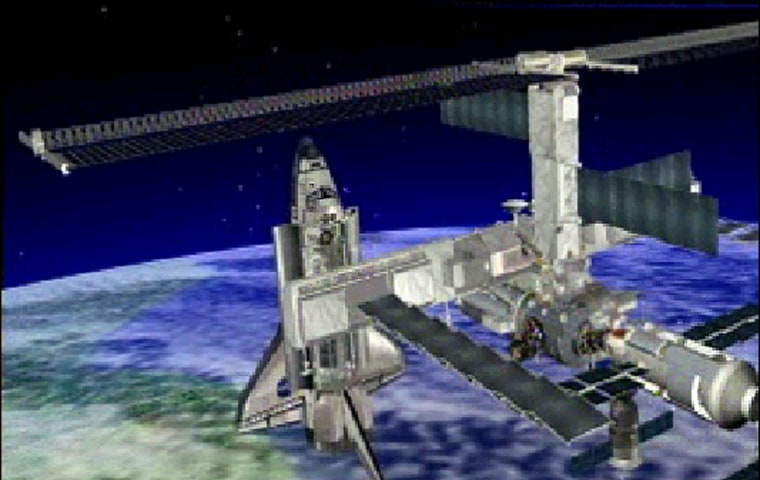NASA officials have confirmed a bizarre observation by amateur satellite trackers following the flight of the international space station and the space shuttle Discovery. Far from causing the 200-ton space station to lose altitude, the space shuttle has actually pushed up the station’s flight path by almost a mile since it docked there late last week.
"The shuttle has raised the station’s orbit by about 4,000 feet (1,220 meters)," Paul Hill, the mission's chief flight director, said Monday. This contrasts sharply with the average daily altitude loss of about 100 feet (30 meters).
Deputy shuttle program manager Wayne Hale, who heads NASA's mission management team, confirmed Hill’s assessment on Tuesday. "We got about seven-tenths of a meter per second speed boost," he told MSNBC.com.
During normal cruise mode, the station is hitting the very thin air at its height of 220 miles (350 kilometers). This very slight — but non-zero — drag is enough to make it lose energy, and as a result it drops into a slightly lower orbit. Due to conservation laws of the physics of motion, this causes the station to slightly speed up as it drops.
Normal space practice is for docked visiting spacecraft to fire their own rocket engines to push the station back up, every few months. The special reboost maneuvers were scheduled when the docked vehicles ignited their engines, using propellant saved during the regular docking maneuvers.
Prior to the loss of Columbia, about half of the total reboost came from shuttles, with the other half coming from Russian robot freighters.
No such reboost maneuver was scheduled for this current flight. Nevertheless, over the weekend, outside observers realized that something was pushing the station higher.
The puzzle surfaces
Last Sunday, amateur satellite observer Kevin Fetter posted a query on See-Sat online discussion group, which brings together an international fraternity of space observers. "When did the shuttle boost the orbit of the ISS?" he asked.
Since no reboost maneuver had been planned or announced, Fetter admitted puzzlement. "So either I am seeing things, or space tracking data is faulty, or I wasn’t paying attention," he concluded.
Fetter’s See-Sat colleague Ted Molczan, widely considered the world’s leading guru of amateur satellite observations, added a message that the orbit had gotten about half a mile (870 meters) higher over the weekend. "I suspect it was a collision avoidance maneuver," he speculated, describing the occasional sudden rocket firings that must be made with only a few hours' notice to steer the station away from nearby space junk.
When a check with ISS activity logs showed no such rocket firing, these observers grew even more baffled. Perhaps, they suspected, a computer problem in the Defense Department space tracking computers was distorting the released values.
The phantom revealed
On Monday, space trajectory experts at NASA’s Johnson Space Center told MSNBC.com that the increase in altitude was absolutely real — and the remarks by Hill and Hale confirmed the nature of the phantom force. It is another "gift" of the visiting shuttle to the space station, and in light of the potentially long wait for the next shuttle mission, a particularly valuable one.
The bonus push that increased the station’s energy and raised its altitude came from the weakest rocket thrusters on the shuttle, the "vernier" (or fine steering) engines. They were firing under autopilot control to maintain the proper stability of the docked shuttle-station complex, and the boosting action is an accidental byproduct of those maneuvers.
The shuttle’s six vernier thrusters are distributed on its nose and tail, and point either sideways or downwards. On this mission, the docked shuttle is positioned nose-up and belly-trailing, so this geometry has the vernier engines facing mostly backward along the orbital path.
This means that when they fire to turn the mated complex in one direction or another, they also impart a small forward push. "Normal attitude control gets propulsive," Hale explained. Hale, whose first specialty in Mission Control dealt with exactly these rocket engines, was referring to a feature of the turning rockets that was a consequence of how and where they were mounted on the shuttle’s body.
This is the first time that a docked shuttle has been positioned at the back end of the station. The change was made purely on safety reasons developed after the Columbia disaster. When the shuttle had previously been positioned at the front end of the complex, it was more vulnerable to running into space junk that could have damaged its heat-shielding skin. For this and most future missions, the entire station is turned around in orbit so the shuttle’s attach point is at the station’s trailing end.
"We are getting an increase in the orbital velocity simply because of where we put the shuttle," Hale explained. This will be the case for most future missions, too.
Saving fuel
The reboost would have cost about 200 pounds (90 kilograms) of rocket fuel if it had to be performed using the old procedure. So the shuttle made another "phantom contribution" to the station equivalent to added payload of that weight.
But there’s a limit to how much of a good thing the station’s orbit can receive, Hale explained. "If we put in more than 1 meter per second," he said, "it will cause concern for the Progress docking," now slated for Sept. 10. It’s not a question of the station being too high, orbital experts explained, but more a matter of the station’s position along its track when the Russian supply robot is launched into space.
Sadly, this means that most of the propellant that commander Eileen Collins saved during her super-efficient rendezvous flying cannot be put for any useful purpose. When the shuttle returns to Earth, the station will be a little bit higher — but nowhere near as much as would have been possible if the Russian rendezvous robot could have been more flexible.
